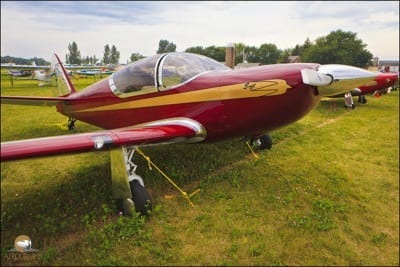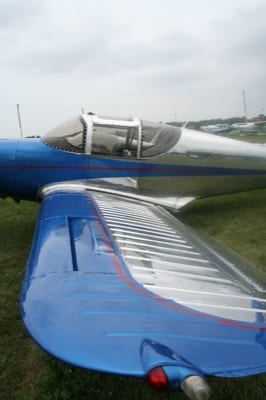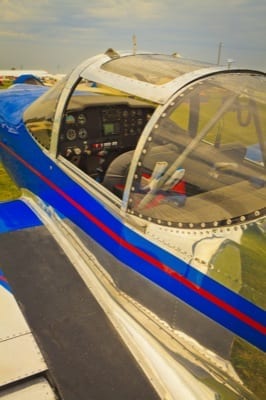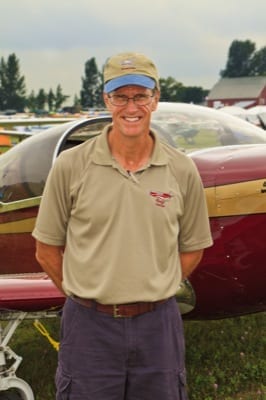When it comes to aircraft production, timing is critical. The history of general aviation is replete with designs that had the misfortune of being introduced at the beginning of the Depression or World War II, and then being lost to a nose-diving economy or a change in resource allocation. If it was a good design, the airplane came back when fortunes changed.
The Swift is one of the designs that went dormant during World War II and came roaring back in the post-war years to become one of the more popular two-place designs on the market. The Swift is a low-wing tailwheel design with side-by-side seating. In some circles, it’s compared to a flying sports car or even the P-51 Mustang.
What grabs you about the Swift when you see them parked in disciplined rows at airshows and fly-ins is the number of subtle variations to the design and finish.  Some are highly polished. Others are painted. Some have a little of both. You’ll find them with sliding canopies and recessed canopies. Some have smooth, one-piece cowlings, others have the characteristic snaggle-tooth grill known as the Swift smile. Look carefully and you’ll find the company logo of a stylized bird in flight. The airplanes are so popular there is a type club, a Swift Foundation and a Swift Museum in Athens, Tenn., at McMinn County Airport (MMI).
Some are highly polished. Others are painted. Some have a little of both. You’ll find them with sliding canopies and recessed canopies. Some have smooth, one-piece cowlings, others have the characteristic snaggle-tooth grill known as the Swift smile. Look carefully and you’ll find the company logo of a stylized bird in flight. The airplanes are so popular there is a type club, a Swift Foundation and a Swift Museum in Athens, Tenn., at McMinn County Airport (MMI).
You’ll always find Swifts surrounded by admirers. Many of the people looking at the airplanes will tell you that they once owned a Swift in the same tone that people speak of a long-lost friend.
History
According to the Swift Museum website, the airplane was designed in 1940 by R.S. “Pop” Johnson of Fort Worth, Texas. Johnson reportedly flew a Culver Cadet, measured it, and reversed engineered it as a starting point for the Swift design, then convinced John Kennedy, the president and founder of Globe Medicine Co. and Globe Aircraft Co. to finance production.
Production of the Swift was tabled during World War II as Globe Aircraft Co. built AT 10s under contract for Beech during the war. Even before hostilities ended, Globe Aircraft Co. decided to build the Swift and hired Johnson as a designer.
Johnson’s prototype of the Swift was a wooden airframe tube and fabric design, but it soon became clear that the flying public wanted a metal airframe. The aircraft were advertised as early as 1944, but didn’t go into mass production until the war ended. There was such a backlog for the airplanes that TEMCO, which stood for Texas Engineering and Manufacturing Co., at nearby Grand Prairie, Texas, was put under contract to build Swifts simultaneously with the Globe production.
The first Swifts had an 85-hp Continental engine. In 1946 a Swift with a 125-hp Continental engine was introduced. Approximately 833 Swifts were churned out in a six-month period. Eventually TEMCO obtained the rights to the Swift and continued to build the airplanes until 1951.
Modifications
Swift owners fall into two categories: Those who want their vintage aircraft to be as close to factory stock as possible, and the owners who are more inclined to make modifications to increase performance, handling and speed.
Robert Gee from Chandler, Texas, falls into the later category.
“The Swift is one of the most modified aircraft in history,” he said when I caught up with him in the vintage parking area of last year’s AirVenture.
 He was proudly showing of his 1946 Globe Swift with the polished silver and Bridgehampton blue trim. “Originally it was an all-polished airplane,” he said, noting he had owned the airplane for about two years. The paint on Gee’s airplane is around the nose and the canopy.
He was proudly showing of his 1946 Globe Swift with the polished silver and Bridgehampton blue trim. “Originally it was an all-polished airplane,” he said, noting he had owned the airplane for about two years. The paint on Gee’s airplane is around the nose and the canopy.
“My painter suggested the paint because that’s where everyone touches the airplane and, when you touch it, it ruins the polish,” he explained. “It is painted the same blue as a 1971 Corvette I own.”
Gee became enamored with aviation as a boy. The first airplane he ever flew in, he says, was a Globe Swift. He was 8 years old and living in Tyler, Texas, at the time.
“I would walk to the airport and look through the fence. One day a guy was taking an all-polished Swift out of the hangar. He said ‘son would you like an airplane ride?’ and I said ‘yes sir!’” Gee remembered.
He grew up to be a corporate pilot and own several airplanes, including an Aeronca Champ and another Globe Swift, purchased in 1960.
Gee described himself as the latest in a long line of caretakers for this particular airplane. “I think it’s had about 15 different owners,” he mused. “It rolled out of the factory in Texas and spent some time there before it went to California, then Alabama. The guy I bought it from was in Houston and he bought it from a guy who had it in Georgia.”
“It was a flying airplane when I bought it. I have overhauled the engine and put a new cowling on it,” he continued. The cowling, Gee noted, is one of the more popular mods.
Gee noted, is one of the more popular mods.
The original Swifts rolled out of the factory with a metal nose cowl that had sort of a snaggle-tooth grin. Many Swift owners, such as Gee, have opted to replace the “smiley face” with a solid cowl made of fiberglass.
During AirVenture Gee made sure his Swift was extra clean because it was for sale. Why sell an airplane you like so much? Because he needed the money to add a sliding canopy to his other Swift.
A few rows down from Gee’s beautiful bird stood Rodney Daulton, Jr. from Tampa, Florida, with the 1949 Swift he inherited from his father.
“Dad found it stuffed in a barn in Denver, Colorado, in the mid-1980s. He had to fix it up to get it home, which was Illinois just outside of Chicago at the time. When he brought it home we completely restored it,” the younger Daulton explained. “Dad is ex-Air Force and ex-American Airlines. Flying is genetic for me! I grew up on a farm grass strip. I have been turning wrenches on Swifts since I was 7 or 8 years old and I soloed in that airplane on my 16th birthday.”
 The Daultons made several modifications to their airplane. They added a 210-hp Continental engine and removed the control yokes and replaced them with control sticks. They also added a bubble sliding canopy.
The Daultons made several modifications to their airplane. They added a 210-hp Continental engine and removed the control yokes and replaced them with control sticks. They also added a bubble sliding canopy.
The mission of the Daulton Swift is the pursuit of the $100 hamburger.
“It gives you a nice sense of pride. It is a people attractor,” Daulton continued. “People never hesitate to come on over. I get in a lot of nice conversation telling people all about it. There are a lot of other Swift pilots out there or ex-Swift pilots who will come over to ask questions or share stories of their airplanes.”
One story you are likely to hear when you talk to a Swift owner is about its ground-handling characteristics.
“It is not like any other tailwheel airplane,” said Daulton. “It is short coupled with light gear and it has its subtle nuances. When someone buys a Swift it’s a good idea to get together with a member of the Swift Association and get an aircraft checkout from a Swift instructor. Most of the incidents and accidents that happen in the airplane happen to high-time airline pilots who don’t have much time in Swifts.”
Originally, the Daulton Swift was polished silver, but when Rodney Jr., took ownership of the airplane he opted to add some paint to cut down on the polishing time.
The enhancements continued in the cockpit, when he went through and upgraded the instrument panel.

“In addition to the steam gauges I put in the ECI gauge with the engine monitor,” he said. “It helps keep the fuel burn down.”
Getting together
The Swift National Convention & Fly-In is held every year in June. This year it was held at Creve Coeur Airport (1H0) in Maryland Heights, Missouri. Next year’s convention is planned for June 5-8, 2013, at McMinn County Airport (MMI) in Athens, Tenn.
